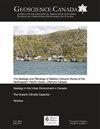遗产石加拿大不列颠哥伦比亚省石英溪Pinolitic菱镁矿的形成:初步岩石学、地球化学和年代学研究的推论
IF 0.8
4区 地球科学
Q3 GEOSCIENCES, MULTIDISCIPLINARY
引用次数: 0
摘要
不列颠哥伦比亚省Quartz Creek的晚元古代Horsewiger Creek群中的岩石显示出罕见的“pinolitic”纹理,类似于世界其他地方一些亮镁矿矿床中描述的纹理。长达30厘米的细长白色菱镁矿晶体出现在由白云石、绿泥石、有机材料、粘土矿物和黄铁矿组成的对比鲜明的深色细粒基质中。这些岩石在美学上很有吸引力,可用于雕塑和尺寸石。“pinolite”一词源于这些不寻常的质地和松果之间的表面相似性。岩石学检查表明,这些结构是在交代流体用菱镁矿取代原生沉积白云石时形成的。流体沿着裂缝和层面移动,重复压裂,在退火裂缝两侧产生方向相反的菱镁矿晶体,并在后期裂缝附近产生破碎的菱镁石晶体。菱镁矿含有白云石微包裹体,钙含量升高,这与白云石置换形成的菱镁矿一致。菱镁矿中Cr、Ni、Co、Ti、Sr和Ba的低浓度也意味着在交代环境而非沉积环境中形成。石英溪菱镁矿中的稀土元素(REE)浓度高于大多数蒸发菱镁矿,并且REE模式缺乏沉积环境中碳酸盐岩特有的Ce和Eu异常。轻REE相对于重REE的富集,以及白云石、绿泥石和菱镁矿REE剖面之间的相似性,表明交代流体在皮诺岩形成过程中改变了白云岩的原始沉积地球化学特征。一个晚奥陶世至早志留纪的U–Pb年龄(433±12 Ma),因为方镁矿周围黑色基质中的钛矿比当地的主岩年轻,也比附近菱镁矿矿床的主岩的中元古代至中寒武纪地层年龄年轻。约433 Ma的钛酸岩与该地区许多断层相关的火山碎屑岩和火山碎屑矿床的年龄重叠。火成活动可能为产生皮诺岩矿床的交代流体提供了热量,和/或是交代流体的来源。本文章由计算机程序翻译,如有差异,请以英文原文为准。
Heritage Stone 8. Formation of Pinolitic Magnesite at Quartz Creek, British Columbia, Canada: Inferences from Preliminary Petrographic, Geochemical and Geochronological Studies
Rocks in the Late Proterozoic Horsethief Creek Group at Quartz Creek in British Columbia display rare ‘pinolitic’ textures resembling those described in some sparry magnesite deposits elsewhere in the world. Elongated white magnesite crystals up to 30 cm long occur in a contrasting, dark, fine-grained matrix of dolomite, chlorite, organic material, clay minerals and pyrite. The rocks are aesthetically appealing for use in sculpture and as dimension stone. The term ‘pinolite’ is derived from the superficial similarities between these unusual textures and pinecones. Petrographic examination indicates that these textures formed when metasomatic fluids replaced primary sedimentary dolomite with magnesite. Fluids moved along fractures and bedding planes with repeated fracturing yielding magnesite crystals oriented in opposite directions on either side of annealed fractures, and broken magnesite crystals adjacent to later fractures. Magnesite contains dolomite microinclusions and has elevated Ca contents that are consistent with its formation by replacement of dolomite. Low concentrations of Cr, Ni, Co, Ti, Sr, and Ba in magnesite also imply formation in a metasomatic rather than a sedimentary environment. The rare earth element (REE) concentrations in the Quartz Creek magnesite are higher than those in most evaporitic magnesite and REE patterns lack the Ce and Eu anomalies that characterize carbonate rocks from sedimentary environments. Enrichment in light REE relative to heavy REE, and the similarities between dolomite, chlorite, and magnesite REE profiles, imply that metasomatic fluids modified the original sedimentary geochemical signature of the dolostones during formation of the pinolite rocks. A Late Ordovician to Early Silurian U–Pb age (433 ± 12 Ma), for titanite in the black matrix surrounding the sparry magnesite is younger than the local host rocks, and also younger than the Mesoproterozoic to Middle Cambrian stratigraphic ages of the host rocks for nearby magnesite deposits. The ca. 433 Ma titanite overlaps the ages for numerous fault-associated diatremes and volcaniclastic deposits in the area. Possibly the igneous activity furnished heat for, and/or was the source for, metasomatic fluids that produced the pinolite deposits.
求助全文
通过发布文献求助,成功后即可免费获取论文全文。
去求助
来源期刊

Geoscience Canada
地学-地球科学综合
CiteScore
3.30
自引率
0.00%
发文量
9
审稿时长
>12 weeks
期刊介绍:
Established in 1974, Geoscience Canada is the main technical publication of the Geological Association of Canada (GAC). We are a quarterly journal that emphasizes diversity of material, and also the presentation of informative technical articles that can be understood not only by specialist research workers, but by non-specialists in other branches of the Earth Sciences. We aim to be a journal that you want to read, and which will leave you better informed, rather than more confused.
 求助内容:
求助内容: 应助结果提醒方式:
应助结果提醒方式:


